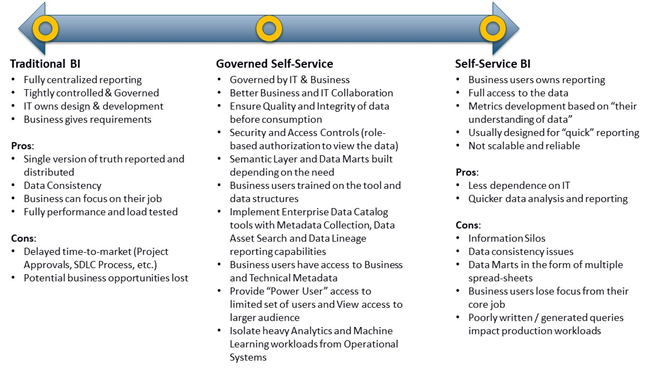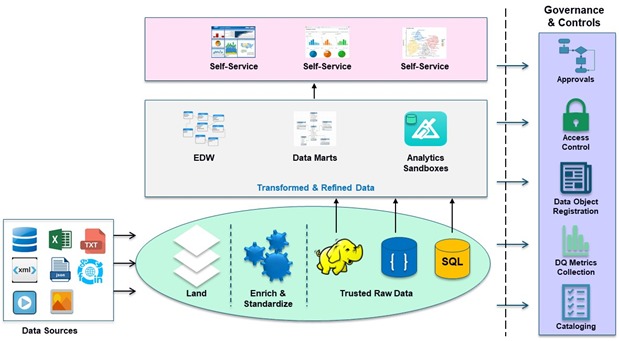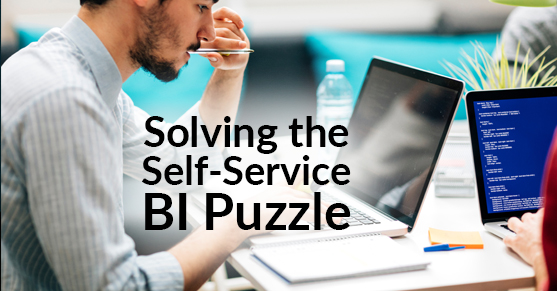Self-Service continues to be a BI buzzword from the last five+ years. Simply put, Self-Service BI is the DIY (do it yourself) of the Reports and Analytics for end users. It is the combination of tools and processes to let the business users perform their own ad hoc analysis and data discovery. Self-Service improves operational efficiency by reducing dependence on IT. Self-Service BI adoption has increased within the past few years. The latest Self-Service BI tools provide the ability to perform Data Preparation, Data Modeling, Data Discovery, and Visualization.
Thirteen years ago, we used to get numerous requests for ad hoc data analysis from business users. We did not have Self-Service tools at the time for complex ad hoc analysis, and many of the business users did not have the skills to query and interpret the data. We used to code SQL queries and share the ad hoc analysis with customers. We used to “productionize” the ad hoc query into a scheduled canned report or parameterized report when we got repeated requests for the same ad hoc analysis.
Today, there is a growing demand for democratizing the data for faster analysis and decision making. We have intuitive Self-Service tools that can be used by the business users (having good analytical skills and knowledge about the data) to perform their own ad hoc analysis. Thanks to many vendors that made the Self-Service data preparation and analysis possible. However, there are some myths and pitfalls that one needs to be aware of:
Self-Service BI Myths
- Using a good Self-Service Visualization tool to develop impressive dashboards is Self-Service
- Providing Self-Service Visualization tool access to business users is “enough”
- Self-Service eliminates the dependence on IT (what about Infrastructure? Governance? Data Quality? Data Modeling? Security? Data Refreshes? SLA Management?)
Self-Service BI Pitfalls
- Providing raw data access without proper “Business Glossary”, “Data Dictionary” leading to “data interpretations”
- Providing the tool and data access without training the users making the implementation ineffective
- No proper infrastructure planning and resource management potentially impacting high priority workloads
- An assumption that all business users are Self-Service users or “power users” making some of the users unhappy
- No proper emphasis on access control leading to confidentiality and privacy issues
- No proper Data Governance and controls in place leading to data silos and Data Quality issues
Factors Influencing Self-Service BI Strategy
With the proliferation of Self-Service tools, growing tech-savvy user-base and increasing demand for business agility, there is no doubt that the business users need to be equipped with the necessary tools for their own data analysis and discovery. However, one needs to take multiple factors into account before devising and implementing a Self-Service strategy.
- Data Security and Privacy
- Data Quality and Integrity
- Regulatory Compliance
- Availability & SLA Management
- Metadata Management and Governance
- Data Processing Roles and Responsibilities
- Tool Access (Do you allow just plug-and-play with any tool? Do you allow users to buy their own tools? Who should get the tool access? What is permitted to be done with the tool? etc.)
Do you have a Self-Service Use Case?
Following questions need to be answered to determine if a true Self-Service use case exists in your organization:
- How many business users are in a role that demands ad hoc reporting, analysis, and data mining?
- How many users need Self-Service?
- What would business users like to Self-Service? (Operational Reporting, Data Discovery and Analysis? Predictive Analytics? What else?)
- How many business users have analytical skills, data preparation skills and the ability to understand the data?
- How many users need “power-user” access vs. “view” access?
- Do you want to “push” Self-Service regardless of the user role and the type of reports required? Then, be prepared to manage the change.
Self-Service BI Implementation Guidelines
- Create Semantic Data Layer
- Implement Data Catalog tools and processes to provide Data Lineage and data asset search capabilities. Strive towards providing up-to-date business and technical metadata to the end users.
- Create and publish Business Glossary and Data Dictionary
- Create proper Governance and Controls in place
- Involve Data Stewards and end users in the Visualization Tool Selection
- Have a common understanding between Business and IT on
- SLA and Performance Expectations
- Data Access Requirements
- Roles and Responsibilities within IT and Business
- Communication and Governance Process (access to new data assets and elements, adding new users, calling for IT help, etc.)
- Data Quality (prioritize and resolve Data Quality issues with Business-IT partnership)
- Train business users on Data, Tool, and Process
- Continuous IT effort to improve Data Quality and business user confidence in data
- Secure data and provide access to authorized personnel
- Data Governance and controls in place to prevent data duplication and data silos
Governed Self-Service
Providing a good Self-Service BI tool to business users or using a good Visualization tool to implement System of Record Reporting and Operational Dashboards is not a true “Self-Service” implementation. An ambitious Self-Service program without proper planning and governance does not give intended results. Let’s look at Traditional BI with full IT Governance and Control at one end of the spectrum and full Self-Service BI Reporting system with no controls in place on the other end. There is a middle-ground – “Governed Self-Service” which is a balanced and recommended approach for true Self-Service implementation.

It is highly recommended to have proper Governance in place to ensure there are no loose ends. However, the type and extent of controls depends on the need and organizational context. This helps in reducing the data chaos and helps in building trust on the data before democratizing it for Self-Service.

Is it the end of Traditional BI?
The current IT trends, products and services offered by IT vendors are helping organizations to be more agile. Analyst reports from past five+ years have consistently placed Self-Service Data Discovery and Visualization tools in a better position compared to Traditional BI tools in terms of growing user base. Big names in the Traditional BI space also improved Self-Service Discovery and Visualization capabilities of their product suites.
Yes, the Self-Service Visualization tools usage has significantly increased within the past few years. However, the significant use of these tools is from IT developers to speed up Operational Reports development and “true Self-Service” implementations are limited. The use cases for Traditional BI reporting (large-scale System of Record Reporting, Operational Dashboards, Scorecards, etc.) are very much alive. Conclusion: Traditional BI and Self-Service BI can coexist in harmony.
Summary
If you have questions about Self-Service BI or need help with implementation/support, please engage with us via comments on this blog post, or reach out to us.

